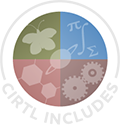What is the Inclusive Pedagogy Framework?
The construction of the inclusive pedagogy framework began by amalgamating the findings from two resources: a) a peer-reviewed synthesis article on inclusive practices in higher education (Salazar et al., 2010) and b) a practical checklist from the Universal Design of Instruction (UID checklist) based on the work of Chickering and Gamson (Does Your Curriculum Provide an Inclusive Environment? Is it IUD Friendly). After reviewing many papers on inclusive pedagogy, we found the Salazar et al. (2010) article to be the most comprehensive account of existing literature on inclusive teaching in higher education to date. The Inclusive Pedagogy Framework includes several practices that promote inclusive teaching. This framework focuses on 3 main aspects of Inclusive Pedagogy: Inclusive Communication, Inclusive Instructional Practices, and Designing Inclusive Curriculum.
Navigating the Inclusive Pedagogy Framework
We wanted the framework to have a structure similar to the previously developed faculty advising and mentoring frameworks. The first step in developing the framework involved a comparison in the core competencies across both sources. Salazar et al. (2010) identifies 5 categories/competencies, and the UID checklist identifies 7 categories, some of which overlapped the categories from Salazar. Missing from the UID checklist was a focus on intrapersonal awareness on behalf of the instructor, which was covered by Salazar et al. (2010). Due to the overlap in the skill sets for the Core Competencies from the two papers, we organized the Inclusive Pedagogy Framework into 3 Core Competencies.
In both papers, each major category included a list of many general skills, strategies, and specific practices. The lists from both references were compared and reduced to account for overlaps in the content. These recommended practices were not further organized based specificity of general skills or specific practices. We compiled the lists of distinct general skills, strategies, and practices from both references, and then organized these inclusive practices from general skills to specific practices.
The general process for organization and assignment of content to the different levels of the framework categories was managed by reaching item-by-item agreement between framework developers. In some cases, categories obtained from the Salazar et. al. (2010) and UID Checklist were further divided to clarify their intent. Most of the Skills were obtained from Salazar et al. (2010) and includes some overlapping topics with the advising framework, e.g. interpersonal skills, intrapersonal awareness. In addition to the 3 Core Competencies, inclusive pedagogy practices are divided into the increasingly more specific areas of Skills, Strategies, and Specific Practices.
Research literature and other sources from Teaching and Learning Centers that support items in the pedagogy framework have been referenced at the end of every corresponding entry. Entries that indicate several sources highlight the overlaps between different sources. We also included a notation in the references for those Strategies and Specific Practices which corresponded to the information obtained at the INCLUDES Summit I meeting.
Guide to the Mentoring, Advising, and Pedagogy Frameworks (PDF)
Inclusive Pedagogy Framework (PDF)
Does Your Curriculum Provide an Inclusive Environment? Is it IUD Friendly.pdf Available at https://www.cte.cornell.edu/documents/presentations/Universal%20Instructional%20Design%20Checklists.pdf
Salazar, M. D. C., Norton, A. S., & Tuitt, F. A. (2010). 12: WEAVING PROMISING PRACTICES FOR INCLUSIVE EXCELLENCE INTO THE HIGHER EDUCATION CLASSROOM. To Improve the Academy: A Journal of Educational Development. 28(1), 208-226.
